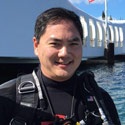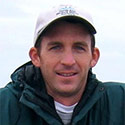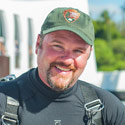

Senior Underwater Archaeologist - National Park Service
Bert is currently a senior underwater archeologist within the National Park Service’s Submerged Resources Center. Prior to joining the SRC, he was a team leader for Navigation Response Team 5 in NOAA’s Office of Coast Survey, tasked with charting harbors, coasts, and navigational emergencies, like the landing of US Airways Flight 1549 in the Hudson River and Hurricane Katrina. As part of his job with the SRC, Bert conducts underwater archeology projects from remote sensing surveys to locate material culture, to site mapping shipwrecks by hand, and other underwater resource documentation projects throughout the National Park Service system and beyond. Bert is particularly interested in submerged WWII aircraft, and has worked at Midway before on sunken aircraft and at other WWII locations within the National Park Service system.

Chief - National Park Service Submerged Resources Center
After undergraduate work in anthropology at Reed College, Dave received a master’s degree from Oxford University in Aegean and underwater archeology and then followed this with a M.A. and a Ph.D. in anthropology and archeology from Brown University. While at Brown Dave began working with the National Park Service’s SCRU (Submerged Cultural Resources Unit) at Dry Tortugas National Park. Upon the completion of his Ph.D. Dave took a NPS underwater archeologist position on detail to the United States Navy. While with the Navy he helped plan and execute the recovery of the world’s first successful combat submarine, the Confederate submersible H.L. Hunley, lost off Charleston South Carolina in 1864. Following the Hunley project, Dave moved to Santa Fe to join the National Park Service’s Submerged Resources Center and work on submerged cultural resources in our National Parks. Notable projects include the search for John Paul Jones’ ship Bon Homme Richard, diving on the wreck of a B-29 Superfortress that crashed into Lake Mead while doing top-secret high altitude research for the U.S. Air Force, diving on the wreck of USS Arizona in Pearl Harbor, working with Ellis Island to document and preserve portions of the historic ferry Ellis Island, diving on WWII German U-boats lost of Cape Hatteras National Seashore, and working with African colleagues to locate and document shipwrecks associated with the global slave trade. In March of 2009 the National Park Service Submerged Resources Center moved from Santa Fe New Mexico to Lakewood Colorado and Dave took over as Chief of the Center. Dave lives in Boulder Colorado with his wife Michelle, who is a Doctor of Oriental Medicine, and dog Luc, who is a Doctor of Chasing Balls.

Resource Protection Manager - Papahānaumokuākea Marine National Monument, Joint Institute for Marine and Atmospheric Research
Brian Hauk is the Resource Protection Manager for the Papahānaumokuākea Marine National Monument (PMNM) and is employed by the Joint Institute for Marine and Atmospheric Research (JIMAR). Hauk holds a MS degree from the University of Hawai’i (UH) in Animal Science specializing in reproductive physiology and life history of fishes. Hauk has over twenty years of experience as a professional/technical scuba diver and boat operator. He leads logistical operations for PMNM projects and oversees PMNM’s marine alien species research, marine debris projects and incident response in the Monument. Hauk has participated in numerous remote ecological research expeditions serving as both a scientific fish and benthic survey diver and as a topside supervisor and diver for technical closed circuit mix gas rebreather operations. Hauk has also been active in training undergraduate scientific divers in underwater ecological survey techniques in an effort to help prepare the next generation of marine research scientist. On this project, he will be investigating submerged cultural resources as potential habitats for alien species.

Field Operations Coordinator - Papahānaumokuākea Marine National Monument, National Ocean Service, Office of National Marine Sanctuaries
Jason oversees fieldwork and diving done to support research activities in the Monument and assists with resource protection projects. Currently, he is working on mesophotic reefs projects using Closed Circuit Rebreathers to help study the deep reefs of the Monument. He love’s pirates, the ocean, watching MMA, and light beer. He was born, raised, and lives in beautiful Waipahu and spends most of his time fishing with his lovely wife and two boys of 9 and 12.

PIFSC Science Operations Coordinator - NOAA’s Pacific Island Fisheries Science Center
Russell Reardon works as the Science Operations Coordinator at NOAA’s Pacific Island Fisheries Science Center (Inouye Regional Center, Oahu). He oversees the day-to-day planning, coordination, and execution of multi-disciplinary ship and shore based research operations and logistics to support Center operations and research throughout the Pacific Islands Region. Russell also serves as the Vessel Operations Coordinator for the Center’s Coral Reef Ecosystem Program, and is responsible for implementing NOAA Small Boat Policy and managing vessel maintenance, operations, and personnel. Russell holds a Bachelor of Science in Natural Resource Conservation from the University of Florida and has enjoyed a fieldwork intensive career geared primarily around boating and diving through his current position with the PIFSC Science Operations Division, as well as previous positions held under entities such as Dry Tortugas National Park, the Florida Keys National Marine Sanctuary, Papahānaumokuākea Marine National Monument, and PIFSC Coral Reef Ecosystem Program.

Deputy Chief - National Park Service Submerged Resources Center
Brett Seymour is the Deputy Chief of the US National Park Service’s (NPS) Submerged Resources Center (SRC) based in Denver, Colorado. Formally known as the Submerged Cultural Resources Unit (or SCRU team), the SRC has been the operational center for the Service’s 250+ divers for nearly four decades. The SRC supports the protection, preservation, public access, and interpretation of submerged resources, both in the US and internationally.
Brett has been working as a full-time underwater photographer with the NPS since 1994. His work with the Service has provided underwater access to some of the United States most captivating national parks. In addition to making a whole new dimension of the Park system available to the public, for past two decades Brett has specialized in documenting historically significant underwater sites around the world. As project photographer on expeditions including the civil war submarine HL Hunley, the arctic exploration vessel HMS Investigator, the submerged B29 Superfortress in Lake Mead, and WWII sites throughout the Pacific including several hundred dives imaging the USS Arizona, Brett has connected the present to the past through underwater imagery.
As the SRC Diving Safety Officer, Brett is responsible for the training, safety, and operations of the Center’s 8-member dive team of underwater archeologists and photographers. He has been utilizing rebreathers in the world of underwater imaging and scientific diving since 2005.
More about the NPS Submerged Resources Center can be found here. Brett’s photographic work documenting the NPS’s underwater realm (among other expeditions) can be found here .